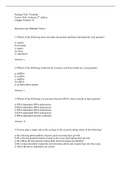Exam (elaborations)
BIOC20 Principles of Virology Final Testbank
- Course
- BIOC20 (BIOC20)
- Institution
- University Of Toronto (U Of T )
Exact mcq questions (prof now changed to short answer) that are on final. Prof only uses this testbank for final.
[Show more]



